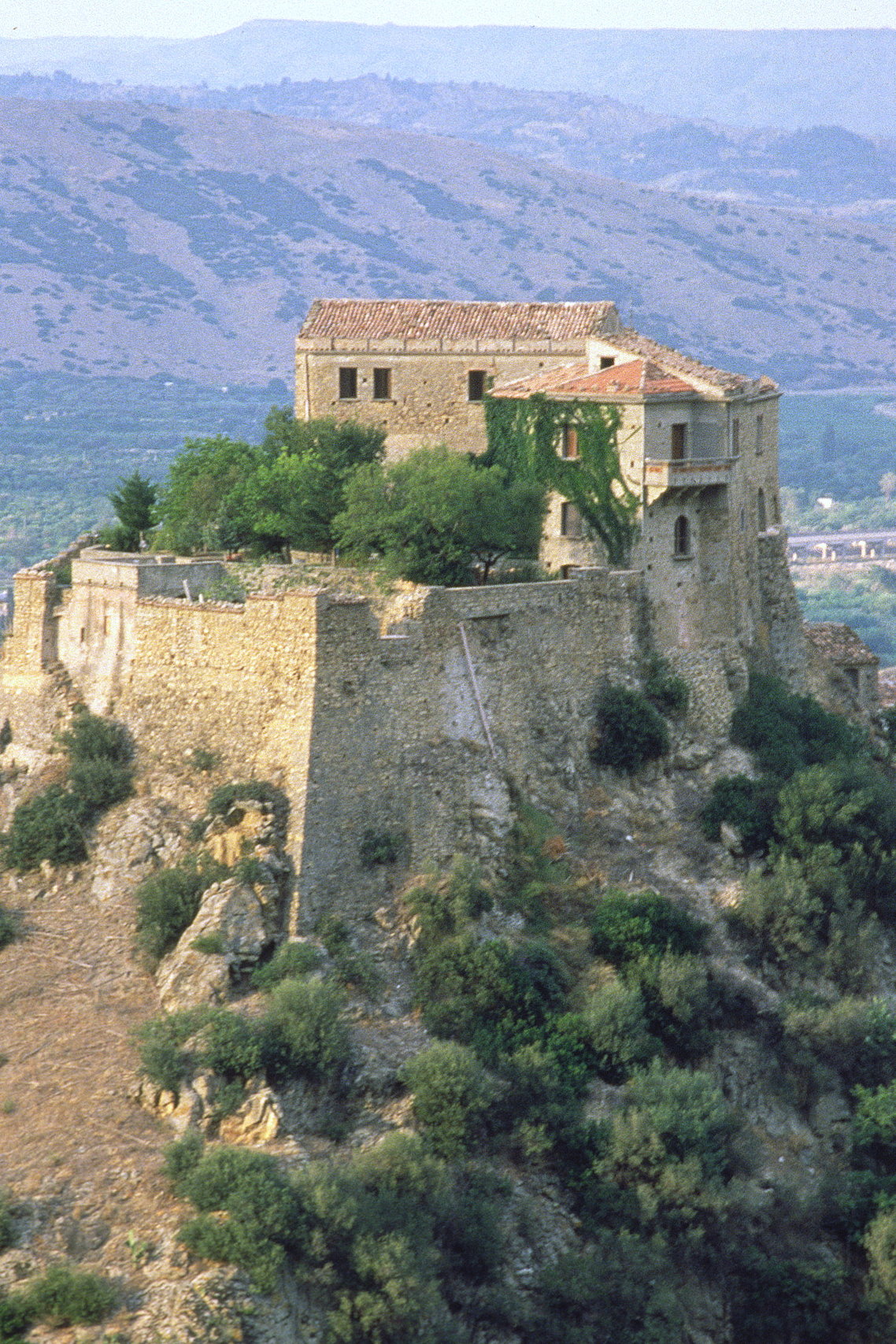Ethnographic Museum of Arberesh Culture
Patrimonio culturale
The building that houses the museum is located in the historic centre of San Costantino Albanese. On the ground floor there is the library of Albanian culture, the iconographic exhibition of the master Josif Droboniku, author of the icons that adorn the municipality’s Mother Church, and the Arbëresh Nativity scene. On the first floor, however, you can visit the collection of objects of rural culture, the precious traditional Arbëresh costumes and the loom for processing and weaving broom.
Museum of Arberesh Culture
Patrimonio culturale
The Museum of San Paolo Albanese presents the extraordinary heritage of traditions of the Arbëresh communities that have lived in the territory of the Pollino National Park for over five centuries. Objects, images, stories, songs and films offer visitors an exciting and unmissable journey into the history and culture of the Arbëresh: from the broom processing cycle, to everyday objects, costumes and songs.
Tramontano Castle of Matera
Patrimonio culturale
The City Castle, whose construction began in the early 16th century at the behest of Count Giancarlo Tramontano, remained unfinished due to the Count’s death in 1515 at the hand of rebel vassals.
Precisely this “incompleteness” makes it particularly evocative and an ideal location for holding important cultural and musical events
Valsinni Castle
Patrimonio culturale
Presumably built on a pre-existing Lombard fortification, in the early 11th century, it is one of the best preserved manors in the region.
“Suggestive in architecture and imposing in the fullness of forms, classic in the series of battlements and embrasures”. This is how Benedetto Croce defined the fortress of Valsinni in “Life of adventures, faith and passion, Isabella Morra and Diego Sandoval de Castro”, when he climbed the rugged cliff, in search of traces of the Petrarca-born poet. Today a national monument, the manor of Aragonese appearance houses works, documents and writings that testify to the existential events of Isabella di Morra. Some of her verses, posthumously written during the anguished imprisonment into which she was forced before her death at the hands of her brothers, still seem to resonate these events.
The Diocesan Museum of Tricarico
Patrimonio culturale
In the17th-century Palazzo Vescovile (bi- shop palace), the oldest diocesan archive in the entire region is kept. The Diocesan Museum of Tricarico features five exhibi- tion sections that display the historical, artistic and archaeological heritage coming from the Cathedral of Santa Maria Assunta and the large diocesan territory. One area is entirely dedicated to the Venerable Mons. Raffaello Delle Nocche, bishop of the Dioce- se of Tricarico from 1922 to 1960.
The Sanctuary of St Rocco in Tolve
Patrimonio culturale
In Romanesque style, the church stands in a dominant position in the historic centre of the town, probably built in the 12th century.
With a three-nave plan, the one on the left side is particularly interesting with three altars, two of which are dedicated to St Biagio and the Sacro Cuore (Sacred Heart), in which a valuable 15th-century wooden polyptych by the Neapolitan school founded by Giotto around 1330 is preserved, and the central one to St Rocco.
In the Church of St Nicola, the 16th-century wooden olive statue of St Rocco, found in the 16th century in a place very close to the town, is carefully preserved. Anyone observing it is enraptured by the intense gaze of the face that hints at a reassuring smile. During celebrations in honour of the Saint of Montepellier, the statue is covered in gold by the faithful.
Literary Park Federico II of Melfi
Patrimonio culturale
The Federico II Literary Park was established in 2015, located in Melfi, and named after Frederick II, emperor and politician, a man of great culture and open-mindedness (his court in Palermo was a meeting place between Greek, Jewish, Christian and Arabic cultures). He was also a writer and poet, but not in the classical sense of the term. In fact, Frederick II had an important role in promoting literature through the poetry of the Sicilian School, he himself wrote the “De Arte Venandi cum Avibus”, as well as having given a mandate to Pier delle Vigne, Papignani and others to renew the laws, work that in 1231 led to the promulgation of the Constitutions of Melfi, collected in the Liber Augustalis.
The objective of the Melfi literary park is to combine the agricultural and engineering interest, which today most characterises the area, with culture. Precisely to promote and make the natural and cultural assets of this territory accessible, the park hosts dedicated events of considerable cultural depth, absolutely not to be missed.
Literary Park Francesco Lomonaco of Montalbano Jonico
Patrimonio culturale
The Francesco Lomonaco literary park was established on 14 July 2019. It is dedicated not only to the author from Montalbano Jonico, one of the protagonists of the revolutionary uprisings for the Neapolitan Republic, nicknamed the Italian Plutarch, friend and teacher of Alessandro Manzoni and doctor of Ugo Foscolo and his brother, as well as author of numerous books, but also to various prominent figures of the Italian cultural scene such as: Nicola Romeo, the abbot Placido Troyli, the priest Nicola Maria Troyli, Niccolò Fiorentino and Prospero Rondinelli.
Nicola Romeo was a scholar of pure geometry, founder of the AlfaRomeo car manufacturer and son of the Montalbanese Maurizio Romeo and Lucia Guida; Abbot Placido Troyli, a Cirstercense monk, was the author of the monumental Historia generale del Reame di Napoli; the priest Nicola Maria Troyli, archaeologist and man of culture, was responsible for discovering the importance of the famous Tables of Heraclea after a chance discovery, a friend of Pope Clement XIV who taught Greek and philosophy; Niccolò Fiorentino was the author of several works including Principi di giurisprudenza criminale (Principles of criminal jurisprudence), Istituzioni di pratica criminale (Institutions of criminal practice), Riflessioni sul regno di Napoli (Reflections on the kingdom of Naples), Ragionamento su la tranquillità della Repubblica (Reasoning on the tranquillity of the Republic), Saggio sulle quantità infinitesime e sulle forze vive e morte (Essay on infinitesimal quantities and on living and dead forces), he died in 1799 of Bourbon shackle in Piazza del Mercato in Naples; and finally Prospero Rondinelli, lifelong librarian, author of the book Montalbano Jonico e i suoi dintorni (Montalbano Jonico and its surroundings), historical and topographical reports and various manuscripts.
It is a virtual park that refers to a real place and alleys, streets, squares, famous people and common people, books, manuscripts, stories, events, and memories. So it has no fences, walls, gates, or visitor opening hours. Its goal is to promote the cultural heritage of a community that needs, as the etymology of the term culture itself suggests, to be “cultivated” and if possible enriched, neither neglecting nor abandoning it.
A place of community memory, therefore, to be continuously enriched, but also a mirror in which to reflect the contemporary world and its challenges and a think tank on new problems and possible answers without detaching from historical and cultural roots.
Literary Park Francesco Mario Pagano in Brienza
Patrimonio culturale
The newly established literary park dedicated Francesco Mario Pagano, famous jurist and patriot from Basilicata, houses the Museo bio-bibliografico (bio-bibliography museum) curated by the “Francesco Mario Pagano” international research centre. The museum boasts over 5,000 books, many of which belonged to this influential exponent of the Enlightenment from Brienza and were donated to the Centre by Irene Giampietro, his heir. In Brienza, it is also possible to visit the key places linked to Pagano’s life and works, the ruins of his native house, perched on the slopes of Caracciolo castle and the works that represent him. There is also a famous painting by Giacomo Di Chirico, which depicts him in 1869, while the judge reads his sentence of death (municipal office of Brienza) and the stunning bronze statue by Achille D’Orsi (1890) in Piazza del Municipio.
International Museum of Grafica - Library “Alessandro Appella” - Atelier chalcographic “Guido Strazza”
Patrimonio culturale
Thirty thousand books and 1350 prints by some of the most important contemporary artists are housed at the MIG, the Interna- tional Museum of Graphics. The museum is known for its excellence across the villages of the Pollino National Park, including Castronuovo di Sant’Andrea, and the entire Basilicata region. In the Museum-Library, the past (Degas, Renoir, Matisse, Bonnard, Picasso, Mirò) is reinterpreted in a mul- ti-faceted way, to better understand the present (Maccari, Melotti, Marino, Accardi). Accurate educational activities are also carried out.
Moreover, the village of Castronuovo boasts two hundred Nativity scenes from all over the world. Housed in the Museo Internazionale del Presepio Vanni Scheiwiller (International Nativity Scene Museum), these artworks come from the collection
of Vanni Scheiwiller, a famous Milanese publisher and that of Giuseppe Appella, an art historian from Castronuovo.
Since August 2017, the four existing cultu- ral centres have been joined by the Museo della Vita e delle Opere di Sant’Andrea Avellino (museum of the life and works of Saint Andrea Avellino). The museum is a treasure trove of relics, books, paintings, drawings and graphic works, which narrate the historical and theological story of this saint, born in Castronuovo and intimate friend of Saint Carlo Borromeo and Saint Filippo Neri.



























